Jump Ahead To:
HOW TO USE A KAYAK FISHING NET – INTRO
Many kayak fishermen become confused when it comes to using a kayak fishing net – but that shouldn’t be the case! This is why I’ve prepared this guide to highlight how to use a kayak fishing net. Take a look for yourself.
Not familiar with kayak fishing nets? Make sure to take a look at our Kayak Fishing Net Ultimate Guide prior to reading this post!
How To Use A Kayak Fishing Net – Overview:

Please note: This post contains affiliate links. An affiliate link means that we may earn advertising/referral fees if you make a purchase through our links.
I’ve compiled this guide to educate you about kayak fishing nets. To make it easier to skim through, I’ve divided the guide up into various sections. Ideally, this organization will allow you to skim the information quickly, then get out on the water using your net!
The first section pertains to which type of kayak fishing net you should consider (trust me, there are several different options and styles and you’ll want to know how to pick the best).

Next, I’ve provided a detailed “how-to” guide on using, installing, and maintaining a kayak fishing net.
After that, I’ve highlighted all the important features you should look for before you buy a fishing net. It is here that I highlight the different types of fishing nets in detail. After reading this, you’ll be able to separate the “best” from the “rest” with ease!

Next, I’ve provided a link to my all-time favorite kayak fishing net. Look, this is NOT the ONLY suitable kayak fishing net. However, I found this net to be the best for amateur kayak fishermen, and I bet it’ll serve you well also!
Finally, I’ve summarized my thoughts in the “My Experience” section. There is even a dorky “pro” and “con” list for those of you (like me) who enjoy that sort of thing!
So let’s take a look at a guide!
Best Kayak Fishing Net – Basics:

Please Note: As an Amazon Associate, I earn from qualifying purchases.
Shortcut to the Best Kayak Fishing Net Review
For the average kayak fishermen, two types of nets are available: casting and handheld. Casting nets are the ones you see some more experienced fishermen using. These are thrown right onto the water and work on the premise that the fish tend to get “stuck” to the net.
While it’s an efficient way to catch fish without putting in much effort, it’s certainly not the best. Many people argue that these nets cut into the gills and scales of fish and thus are not the most fish-friendly (not ideal for those of you who like to “catch and release”).

As opposed to that, a handheld net is more oriented towards fish-friendliness. It isn’t harsh on the fish’s gills and is a great choice for catch-and-release kayak fishermen!
But it’s not just the type of fishing net. You need to consider the material of the mesh as well. Nylon meshes are the most common (particularly in recent years). This material is preferred as it’s highly resistant and can withstand harsh sunlight and salty water. It is also very lightweight, so you can maneuver the net with ease!
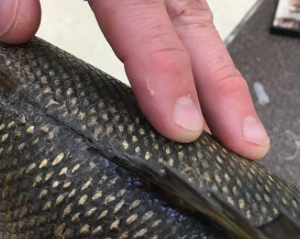
For catch-and-release purposes, consider a softer mesh that doesn’t scrape away the mucosal lining of the gills (we show a picture of this below so you know what we are referring to). Flat bottom rubber nets are the best for this, as the mesh is non-invasive and the flat bottom gives you a good view of the catch (important for your social media posters).
Side Note: One you’ve mastered using the net, learn about the Best Kayak Paddle for Fishing (just make sure you pair it with the Best Kayak Paddle Grip Tape)!
How To Use A Kayak Fishing Net:

Using a kayak fishing net is as simple as it sounds. However, there’s a lot you need to know when you’re out fishing in the water. Here’s how you can use your net while fishing on a kayak:
- Unbox the net.
- Set up your net using the instructions provided.
- Depending on the type of net you have, it can come either folded or in two separate parts.
- Once you’re done setting up, learn where and when you should fish.
- Get a catalog of the various fish species that lurk in your preferred body of water.
- Also, see what time of year and day they are most active.
- Some fish can be found in shallower water, in between crevices of exposed rocks, and under the apex of cliffs.
- If you’re fishing around a lot of vegetation, you can use a bait to lure the fish out first.
- When you’re done fishing, be sure to wash the net with fresh clean water.
- Dry the net after every use, as soaked up water can invite bacteria and odor.
- Air drying is best and, once dry, you won’t have to worry about mold or mildew!
- Fold you net up and store it in a dry, dark place with relative temperature controls (not outside in a shed, for example).
Side Note: If you liked this “how to” guide, you might also like learning How to Use a Kayak Rack for Dock, How to Use Kayak Paddle Grips, or How to Use a Kayak Paddle Holder!
Best Kayak Fishing Net – Important Features:

Type of Fishing Net:
First things first, what type of net do you prefer? I stated before that there are two types: casting and handheld. But which is right for you?
Casting nets are preferred by those who want to catch more fish in a larger area. It’s more or less for bulk fishing. A lot of amateur and professional kayak fishermen use this net to catch, or at least attempt to catch, “in bulk”. This makes it ideal for people who want to sell fish at a local market – but we suspect that this isn’t applicable to the average KFC reader.

However, keep in mind that casting nets are not fish-friendly. Since they aren’t closed, they rely on the ability to snag on a fish’s gills and scales. This can be detrimental to the fish’s health, not to mention painful. We much prefer to be more “fish friendly” and, for that reason, we prefer the handheld style of kayak fishing net!
Handheld nets are great for novices. They work great in all types of water bodies. And a lot of them don’t materially harm the fish! Plus, if you get the flat bottom nets, you can use them for catch-and-release purposes too. I recommend buying a handheld net if you’re just starting out – you’ll be glad that you did.
Handle Type and Length:
Next, check what type of handle the net has. There are three kinds: retractable (telescopic), separable, and foldable. Retractable or telescopic nets are the most portable. The handle collapses down to save space in your bag or the hull of your kayak – whichever storage space you use.
The separable kind is also portable, as it can break into two separate halves. Foldable nets aren’t the best as only the mesh can be folded down. But you can just carry them in your hands if portability isn’t an issue for you.
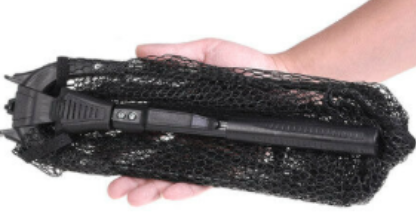
As for the length of the handle, decide between short, medium, and long handles. Short handles are less likely to break but have a lower weight capacity. There is a bit of a balancing act here.
Longer handles will break more often, but they can hold more weight. Almost seems like a catch 22, right? Plus, you won’t have to lean forward to reach into the water, making them great for kayak fishing, especially when you are fishing in the shallows or areas of swiftly moving current.
Handle Material:
Handles are all about rigidity (no, really, you do not want them to bend). A good handle won’t snap or bend and will have a decent weight capacity.
For this reason, aluminum is the best choice of material. It’s lightweight and durable. I do find that aluminum tends to be more “flexible”. But most aluminum handles I’ve tested don’t bend very easily. Aluminum alloy is not only resistant to water but it is also resistant to general corrosion – important considerations for kayak fishermen due to the constant “wet” nature of the sport.
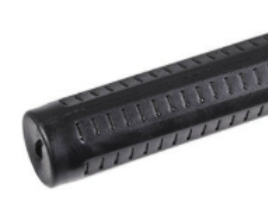
However, if you want something better than aluminum, try carbon fiber. It’s lighter, more rigid, and can take more damage as compared to its aluminum counterparts. The only downside is that carbon fiber handles cost more. However, you need to balance the extra cost with the reality that you will likely use only one or two kayak fishing nets for many seasons in a row – perhaps the quality is worth the extra expense?
Wood is also a choice of material, but it’s not the best. It’s biodegradable and isn’t recommended for use in saltwater. Steel, even the galvanized version, is quite susceptible to rusting and UV damage.
Mesh Material:
Mesh materials are evaluated based upon how light, durable, and fish-friendly the mesh is. Nylon is the most suitable choice here. It’s resistant to UV damage and oxidation. It’s not waterproof on its own but can be treated to be so.
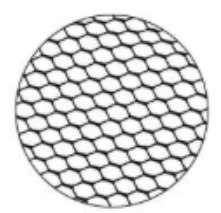
But nylon is known to snag at the fish’s gills and scrape away the natural mucosal lining. Which is why many people prefer rubber for its friendlier surface and softer texture. It’s not as durable as nylon but it’s great for catch-and-release (a style of fishing most common to the “average” kayak fisherman).
Mesh Size and Shape:
Lastly, consider the size and shape of the mesh. The preferred net volume differs from specie to specie, so be sure to keep that in mind when you are deciding among different nets. For some larger fish, a depth of 45 inches is preferred. For some medium sized fish, choose a 36-inch deep net. And for even smaller fish (such as trout, perch or sunfish), buy a 24 inch deep net.
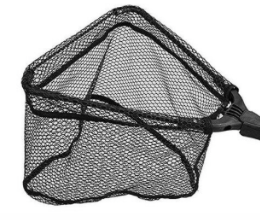
Apart from that, consider the shape of the net. Flat bottom nets are the best for viewing fish as you catch them. These are popular among catch-and-release enthusiasts. The “flat bottom” of the net allows the fish to rest comfortably at the bottom of the net, with all of its beauty on display for viewing and a quick photo or two!
Buy the Best Kayak Fishing Net:
If you were to ask me for a suggestion, I would recommend the kayak fishing net that we’ve showcased above. Now, its not the ONLY top quality model out there, but it has served me quite well over the years and I suspect that you’ll be happy with it as well.
First up, let’s talk about the materials. Durability is key to a good kayak fishing net – just like it is for nearly every other piece of kayak fishing gear. And this net focuses on just that! The handle is 27 inches long and made from carbon fiber and fiberglass. As I’ve already mentioned, carbon fiber is the best choice of material. It even surpasses aluminum alloy in terms of durability.
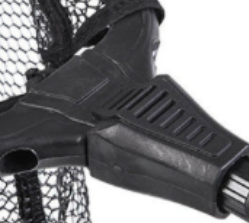
The manufacturer has taken great care such that the mesh has been carefully woven from premium-quality nylon. For those of you who don’t know, nylon is highly resilient (one of the most durable materials in the space, actually). It can survive damage from the sun, water, salt, and oxidation – all of which are very much present during any routine kayak fishing outing. It’s been treated to resist water, which means that it won’t soak up odor and impurities – this helps it remain free of conditions that give rise to mold and mildew, leading to a foul odor!

But the one thing I like the most is the shape of the net. It’s triangular with a flat bottom, making it ideal for catch-and-release purposes. Again, this is the PERFECT design for allowing a caught fish to rest flatly and easily on the bottom of the net – its beauty on display for all to see and appreciate!

Moreover, the handle is telescopic and the mesh can be folded down. This makes it highly portable and ideal for carrying in a backpack. This is why this particular net is so popular among those who frequently go kayak fishing on backpacking trips!
My Experience

My experience fishing with the showcased kayak fishing net has been quite positive. This fishing net has taken so much damage, over the seasons, and yet it’s still intact – with many fish to its name!
One thing I should warn you about is that the handle length is in the short-range. So you shouldn’t use it over whitewater (or if you are concerned about “leaning” out over the edge of your kayak when bringing in a fish). But other than that, this is a great product to help you increase your catch. The mesh doesn’t even snag any fishing hooks!
For clarity, here’s what I think in terms of a simple “pro” and “con” list:
Pros:
- Does not absorb water (good for keeping free from mold/mildew).
- Great for use in calm water.
- Handle does not bend (good for ensuring that the net doesn’t bend to an angle that would allow a fish to flop out).
- Mesh does not absorb odor.
- Great for catching medium to small sized fish (if you fish for larger species, we suggest that you look into larger nets).
- Ideal for carrying in a backpack (due to its collapsable nature).
Cons:
- Not for whitewater (nor for those who have concerns about “leaning” out over the edge of a fishing kayak, which, to be clear, would not be a concern if you learned How to Use Kayak Outriggers).
Conclusion:

So that wraps up the kayak fishing net guide! I hope you learned a lot about how to use a fishing net on your next kayak fishing outing! I can’t think of a single detail that we’ve neglected to write about!
For me, the kayak fishing net that we showcase in this post is a perfect choice. It is practically invincible and has helped me catch tons of small to medium sized fish season after season. I recommend it for ease of use and unbreakable construction.
Comments

So what about you? What do you use to complete the last step of a kayak fishing catch when you need to bring the fish from the water into the safety of the kayak? Perhaps you have used a kayak fishing net in the past and have had good luck with it? Maybe you’ve even had experienced with the model that we have showcased in this post and want to share some feedback?
Be sure to reach out to us by posting in the Comments section below! We read and reply to every comment and love interacting with the kayak fishing community!


